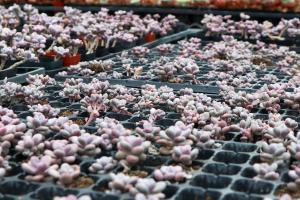How to Overwinter Potted Strawberry Plants
Strawberries are a delicious and nutritious fruit that can be grown successfully in containers. But what happens when the temperature drops and winter sets in? Do you need to throw away your potted strawberry plants and wait for spring to replant? Not necessarily. With a few steps, you can successfully overwinter your potted strawberry plants, ensuring they will thrive and produce fruit for many growing seasons to come.
Step 1: Choose the Right Variety
When selecting strawberries for container gardening, choose a variety that is best suited for your climate. Some varieties of strawberry plants are more cold-hardy than others. For example, the everbearing and day-neutral varieties are better suited for overwintering than the June-bearing varieties. Before purchasing your plants, do some research on which varieties are best suited for your region.
Step 2: Protect Your Potted Plants from the Elements
Don’t leave your potted strawberry plants out in the elements during the winter. If you live in an area with harsh winter conditions, it’s best to bring your potted plants inside. Place them in a cool, well-lit area, such as an unheated basement, attic, or garage. Be sure to keep the soil moist, but not wet. If you can’t bring your plants indoors, wrap the container in bubble wrap or burlap to insulate the roots and protect them from extreme temperature fluctuations.
Step 3: Reduce Fertilization and Watering
Strawberry plants go dormant during the winter months, so they require less water and fertilizer. Reduce the amount of water you give your plants and stop fertilizing them until spring. If you overwater or over-fertilize your plants during the winter, you risk killing them. A good rule of thumb is to check the soil once a week. If it’s dry to the touch, add water. If it’s moist, wait a few more days.
Step 4: Prune Away Dead Leaves and Stems
During the winter, it’s normal for strawberry plants to shed some of their leaves and stems. To prevent the plant from wasting energy on dead or damaged branches, prune them away. Cut back the leaves and stems to about ? inch above the crown of the plant. This will encourage new growth in the spring.
Step 5: Monitor the Plants for Pests and Diseases
Even though your plants are dormant, they can still be susceptible to pests and diseases. Keep an eye out for signs of mold, fungus, and insect infestations. If you notice any issues, treat them immediately with an organic solution such as neem oil or insecticidal soap.
Step 6: Prepare for Spring
As the weather starts to warm up, your potted strawberry plants will start to wake up from their winter slumber. When you start to see new growth, you can return to your regular watering and fertilizing schedule. Be sure to provide plenty of light and warmth to encourage new growth.
By following these simple steps, you can successfully overwinter your potted strawberry plants and enjoy delicious, fresh fruit for years to come.

 how many times do yo...
how many times do yo... how many planted tre...
how many planted tre... how many pine trees ...
how many pine trees ... how many pecan trees...
how many pecan trees... how many plants comp...
how many plants comp... how many plants can ...
how many plants can ... how many plants and ...
how many plants and ... how many pepper plan...
how many pepper plan...
































